The Old Craftsman Scroll Saw Manual provides essential guidance for safe and effective use, covering operation, maintenance, and troubleshooting. It ensures optimal performance and longevity of the tool.
1.1 Importance of the Manual for Safe and Effective Use
The manual is crucial for ensuring safe and effective operation of the Old Craftsman Scroll Saw. It provides detailed safety guidelines, operational instructions, and troubleshooting tips, helping users avoid accidents and maintain optimal performance. By understanding the tool’s limitations and proper usage, users can achieve precise cuts and extend the saw’s lifespan. Regular maintenance and adherence to warranty conditions are also emphasized, ensuring reliability and longevity. Following the manual’s instructions is essential for mastering the scroll saw’s capabilities while minimizing risks.
1.2 Key Features of the Old Craftsman Scroll Saw
The Old Craftsman Scroll Saw is renowned for its variable speed control, enabling precise cutting on various materials. It features a durable construction, designed for consistent performance and longevity. The tool supports multiple blade types, including standard and pinless options, making it versatile for intricate designs. Additional features include an overload breaker for safety and an easy-access on/off knob with speed adjustment. Its compact design and robust build make it ideal for woodworking and crafts, ensuring accuracy and control for both beginners and experienced users.

Safety Precautions and Guidelines
Safety is crucial when operating the Old Craftsman Scroll Saw. Always read the manual, follow safety rules, and stay alert to prevent accidents and ensure proper function.
2.1 General Safety Tips for Operating a Scroll Saw
Always read the manual thoroughly and understand the tool’s application and limitations. Wear proper safety gear and keep loose clothing tied back. Ensure the work area is clean and well-lit. Avoid distractions while operating the saw. Never touch moving parts or blades with your hands. Keep children and pets away. Stay alert and maintain control of the saw at all times. Familiarize yourself with emergency stop procedures. Proper safety practices ensure safe and efficient operation of the Old Craftsman Scroll Saw.
2.2 Understanding Safety Warnings in the Manual
The manual emphasizes critical safety warnings to prevent accidents. It highlights the importance of reading and understanding the manual before use. Specific warnings include avoiding loose clothing, keeping hands away from moving parts, and ensuring proper blade installation. The manual also stresses the need to follow safety rules and guidelines meticulously. Adhering to these warnings ensures safe operation and prevents potential hazards. The Old Craftsman Scroll Saw Manual prioritizes user safety, making it essential to review and comply with all provided instructions and precautions;
2.3 Common Hazards and How to Avoid Them
Common hazards with the Old Craftsman Scroll Saw include blade binding, motor slowdown, and improper blade installation. Blade binding occurs when the workpiece is fed too quickly, causing the blade to bog down. To avoid this, feed materials at a steady, controlled pace. Motor issues can arise from overloaded operations; ensure the saw is used within its power capacity. Improper blade installation can lead to unsafe operation, so always follow the manual’s installation guidelines. Regular maintenance and adherence to safety rules minimize these risks, ensuring safe and efficient use of the scroll saw.
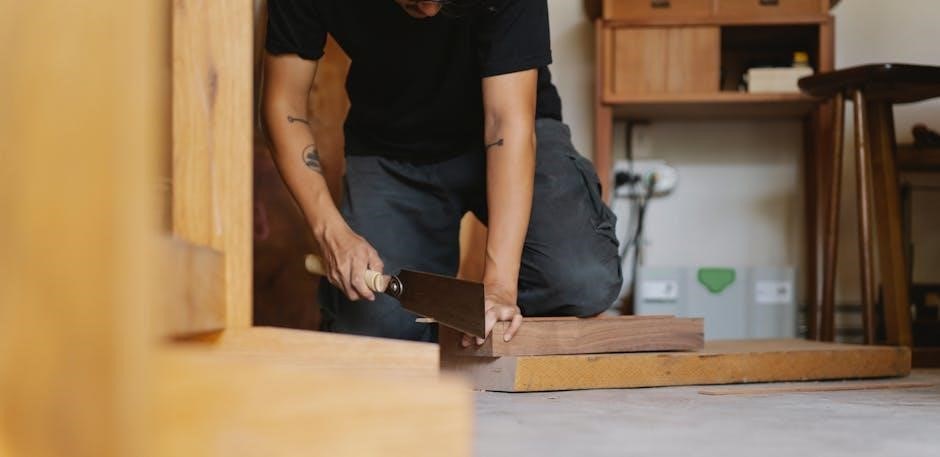
Parts and Components of the Scroll Saw
The Old Craftsman Scroll Saw features a variable speed control, durable blade holders, and a sturdy work table. The manual details these components for optimal functionality and safety.
3.1 Overview of the Scroll Saw’s Major Components
The Old Craftsman Scroll Saw consists of key components like the variable speed control, blade holders, and a sturdy work table. The manual highlights these parts, ensuring users understand their functions and importance for safe operation. The saw also features a reliable motor, dust collection ports, and an overload breaker to prevent damage. These components work together to provide precise cutting and durability, making the scroll saw a versatile tool for woodworking and intricate designs.
3.2 Detailed Parts List from the Manual
The manual provides a comprehensive parts list, detailing components like the blade holders, variable speed control, and work table. It also includes the motor, dust collection system, and overload breaker. Each part is described to ensure proper identification and assembly. Understanding these components is crucial for safe operation and maintenance. The list helps users locate and replace parts efficiently, ensuring the scroll saw remains in optimal working condition. This detailed breakdown is essential for troubleshooting and maintaining the tool effectively.
3.3 Understanding the Variable Speed Control
The variable speed control on the Old Craftsman Scroll Saw allows users to adjust the blade’s speed, optimizing performance for different materials. This feature ensures precise cutting and reduces vibration. By referring to the manual, users can learn how to set the ideal speed for various projects. Proper adjustment prevents overheating and extends blade life. The manual emphasizes the importance of understanding this control for safe and efficient operation, ensuring the saw performs at its best for intricate designs and heavy-duty tasks alike.
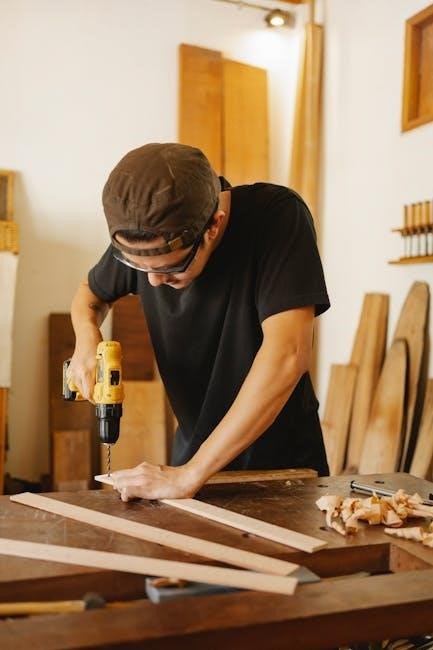
Assembly and Installation Instructions
The manual provides a step-by-step guide for assembling the scroll saw, including blade installation and workbench mounting, ensuring a secure and stable setup for operation.
4.1 Step-by-Step Assembly Guide
The manual outlines a detailed assembly process for the Old Craftsman Scroll Saw, starting with unboxing and organizing components. It guides users through attaching the saw to its stand, aligning the arm, and securing all parts. Instructions emphasize ensuring all bolts and connections are tightened properly for stability. The guide also covers installing the blade guard, tensioning the blade, and testing the saw’s movement. Clear diagrams and sequential steps help users avoid errors, ensuring the tool is ready for safe and efficient operation right out of the box.
4.2 Installing the Saw Blade
Installing the saw blade requires careful attention to ensure proper alignment and tension. Begin by lifting the blade guard and positioning the blade between the upper and lower clamps. Align the blade’s teeth with the saw’s direction of cut. Secure the blade by tightening the clamps evenly, ensuring it is taut but not overly stressed. Adjust the tensioning lever to achieve the recommended tension, then lower the blade guard. Proper installation ensures accurate cuts and prevents blade breakage. Always reference the manual for specific blade type recommendations and installation guidelines.
4.3 Mounting the Scroll Saw on a Workbench
Mounting the scroll saw on a workbench ensures stability and prevents vibration during operation. Choose a sturdy, flat workbench and position the saw in a convenient location. Use the mounting hardware provided in the kit or recommended by Craftsman. Align the saw’s base with the bench and secure it using bolts, ensuring tightness. Double-check the saw’s level to maintain accuracy. After mounting, ensure the motor and blade area are free from obstructions. Proper mounting enhances safety, precision, and ease of use during cutting tasks.
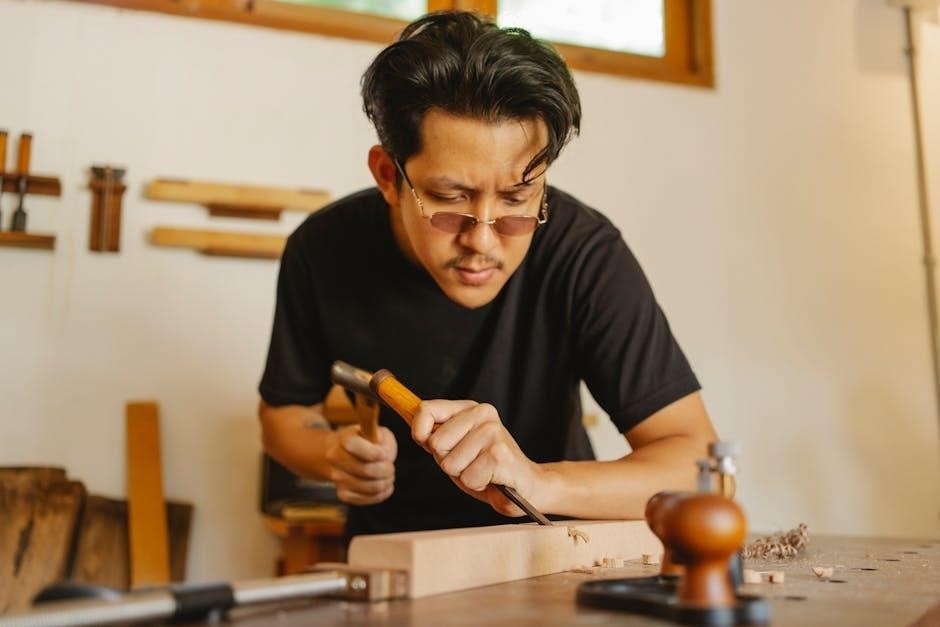
Blade Selection and Maintenance
Selecting the right blade ensures precise cuts and optimal performance. Maintain blade sharpness by cleaning and storing properly; Regularly inspect and replace worn or damaged blades for safety and accuracy.
5;1 Types of Blades Recommended by the Manual
The Old Craftsman Scroll Saw Manual recommends using high-quality blades designed for specific materials. Standard blades are ideal for general woodworking, while skip tooth blades handle thicker materials. Reverse tooth blades minimize splintering, and spiral blades excel at intricate curves. The manual emphasizes choosing the right blade type for the project to ensure precision and safety. Always consult the manual for blade specifications tailored to your scroll saw model and material requirements.
5.2 How to Choose the Right Blade for Your Project
Selecting the right blade ensures safety and optimal results. The manual advises choosing blades based on material type, thickness, and desired cut precision. For straight cuts, standard or skip tooth blades are ideal, while spiral blades are best for intricate curves. Blade tooth configuration and material compatibility are critical factors. Always consult the manual for specific blade recommendations tailored to your project needs to ensure proper performance and safety. This guidance helps maximize the scroll saw’s efficiency and achieve professional-level results consistently.
5.3 Blade Maintenance Tips for Longevity
Regular blade maintenance is crucial for extending longevity. Clean blades after each use to prevent rust and material buildup. Lubricate the blade periodically to reduce friction and wear. Store blades in protective sleeves to avoid damage. Avoid exposing blades to harsh chemicals or extreme temperatures. Inspect blades for dullness or damage and replace them when necessary. Proper care ensures consistent performance and prevents premature blade failure. Always follow the manual’s guidelines for blade maintenance to keep your scroll saw operating at its best.
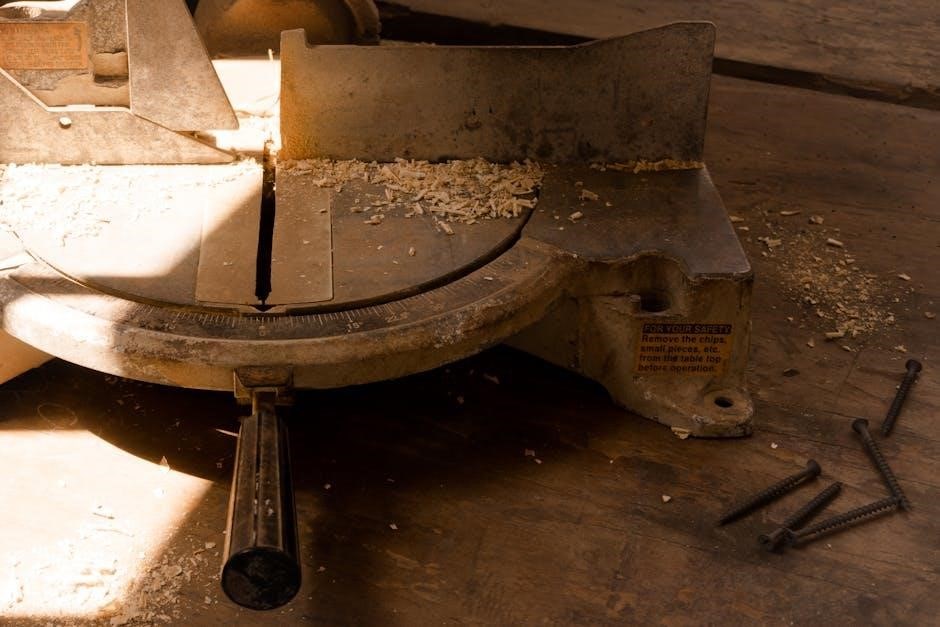
Operating the Scroll Saw
Operating the scroll saw involves starting the motor, adjusting speed, and using proper cutting techniques. Always follow safety rules and best practices for precise results.
6.1 Starting the Saw and Adjusting Speed
To start the scroll saw, locate the power switch and turn it on. Adjust the variable speed control to match the material thickness and type. Monitor the RPM to ensure smooth operation. Always maintain a steady workpiece feed rate to prevent blade binding. Proper speed adjustment enhances cutting accuracy and prolongs blade life. Refer to the manual for specific speed recommendations for different materials. Ensure the saw is stable and well-lit before beginning any project. This setup ensures safe and efficient operation.
6.2 Proper Technique for Cutting Different Materials
Proper technique involves matching blade speed and type to the material. For wood, use a steady, consistent feed rate, while metal requires slower, precise movements. Always hold the workpiece firmly on the table. Maintain a steady feed rate to avoid blade binding. Use smooth, controlled motions to follow patterns accurately. Apply gentle to moderate pressure, depending on material thickness. Monitor blade stress and adjust speed as needed. Proper technique ensures clean cuts, minimizes wear on the blade, and enhances overall safety during operation.
6.3 Using the Saw for Intricate Designs and Patterns
For intricate designs, use a fine-tooth blade and maintain steady control. Keep the workpiece firmly secured to the table. Feed the material smoothly, following the pattern closely. Reduce speed for detailed cuts and use a steady hand to avoid deviations. Apply gentle pressure and ensure the blade stays aligned with the design. Regularly pause to inspect progress and adjust as needed. Proper technique and patience are key to achieving precise, intricate cuts in various materials, including thin wood, plastic, or metal.

Troubleshooting Common Issues
Address common issues like blade alignment, motor noise, or speed control by checking blade tension, ensuring proper installation, and consulting the manual for detailed solutions.
7.1 Diagnosing Blade Problems
Blade issues are common and often stem from improper installation or wear. Check for misalignment, dullness, or damage. Ensure the blade is securely clamped and properly tensioned. If the blade vibrates excessively or breaks frequently, inspect for debris or incorrect sizing. Refer to the manual for specific troubleshooting steps, as outlined in the Craftsman scroll saw guide. Addressing these problems early prevents further damage and ensures smooth operation. Always prioritize blade maintenance for optimal performance and safety.
7.2 Solving Motor and Speed Control Issues
Motor and speed control problems can often be resolved by checking the power supply and ensuring all connections are secure. If the saw operates erratically, inspect the speed control dial for proper function. Lubricate moving parts and verify blade tension, as improper tension can strain the motor. If issues persist, consult the troubleshooting guide or contact Craftsman support. Always use genuine replacement parts to maintain performance and safety, as specified in the manual. Regular maintenance helps prevent such issues and ensures smooth operation.
7.3 Addressing Vibration and Noise Problems
Vibration and noise issues often arise from improper blade tension or misalignment. Ensure the blade is securely fastened and properly aligned. Check the workbench for stability and tighten any loose bolts on the saw. Excessive noise may indicate worn or dirty components, which should be cleaned or replaced. Using the correct blade type and maintaining proper lubrication can also reduce vibration. Refer to the manual for specific adjustments and always operate the saw on a level, rigid surface to minimize noise and vibration for smoother operation.

Maintenance and Upkeep
Regular cleaning and lubrication are crucial for maintaining performance. Check and replace worn parts promptly. Proper storage ensures longevity and optimal functionality of the scroll saw.
8.1 Regular Cleaning and Lubrication
Regular cleaning and lubrication are essential to maintain the scroll saw’s performance. Remove dust and debris from the saw’s surface and internal components using a soft brush or cloth. Lubricate moving parts, such as the arm and pivot points, to ensure smooth operation. Refer to the manual for specific lubrication recommendations. Regular maintenance prevents wear and tear, ensuring precise cuts and extending the tool’s lifespan. Always follow safety guidelines when performing maintenance tasks.
8.2 Checking and Replacing Worn Parts
Regularly inspect the scroll saw’s components, such as blades, tensioning mechanisms, and pivot points, for signs of wear. Replace worn or damaged parts immediately to prevent further damage or unsafe operation. Always use genuine Craftsman replacement parts to ensure compatibility and performance. Refer to the manual’s parts list for identification and ordering information. Proper replacement of worn parts maintains the saw’s accuracy and extends its service life; Addressing wear promptly avoids costly repairs and ensures consistent results in your woodworking projects.
8.3 Storage Tips to Maintain Saw Performance
Store the scroll saw in a dry, clean environment to prevent rust and damage. After use, thoroughly clean the saw, removing dust and debris. Apply a light coat of lubricant to moving parts to protect against corrosion. Cover the saw with a protective cover to shield it from dust. Ensure the blade is properly secured or removed to avoid accidental injury. Store extra blades separately in a labeled container. Regularly inspect stored parts for wear or damage before reuse. Proper storage ensures the saw remains in optimal condition for future projects.
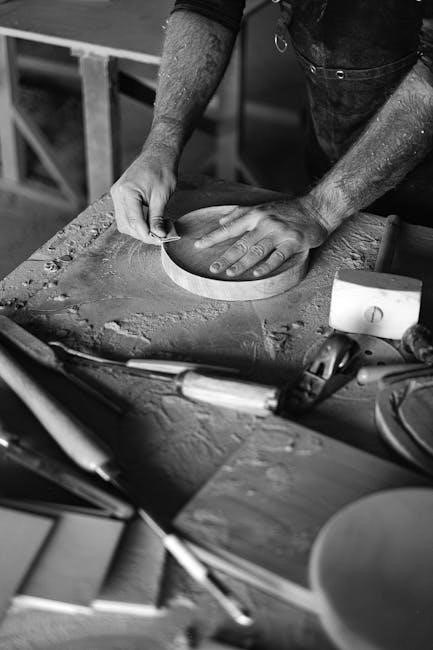
Warranty and Service Information
The Old Craftsman Scroll Saw Manual includes a one-year warranty covering defects in material and workmanship. Contact Sears for repairs or replacements within the warranty period. Follow the manual’s instructions to claim service and reach customer support for assistance.
9.1 Understanding the One-Year Full Warranty
The Old Craftsman Scroll Saw Manual outlines a one-year full warranty, covering defects in material and workmanship. This warranty ensures that if the tool fails within one year of purchase due to manufacturing issues, Sears will repair or replace it free of charge. The warranty underscores Craftsman’s commitment to quality and customer satisfaction, providing peace of mind for users. It is essential to review the manual for specific terms and conditions to understand what is covered and how to utilize this benefit effectively.
9.2 How to Claim Warranty Service
To claim warranty service for your Old Craftsman Scroll Saw, review the manual for specific instructions. Contact Sears customer support with proof of purchase and a detailed description of the issue. Ensure the tool is within the one-year warranty period and that the defect is due to material or workmanship. Follow the provided guidelines to initiate the repair or replacement process, ensuring all requirements are met for a smooth and efficient resolution;
9.4 Contacting Craftsman Customer Support
To contact Craftsman customer support, visit their official website or refer to the manual for contact details. Call their toll-free number, email, or use the online support portal. Provide your tool’s model number, purchase date, and a clear description of the issue. Support is available to address warranty claims, troubleshooting, or general inquiries. Ensure you have all necessary documentation ready to expedite assistance.
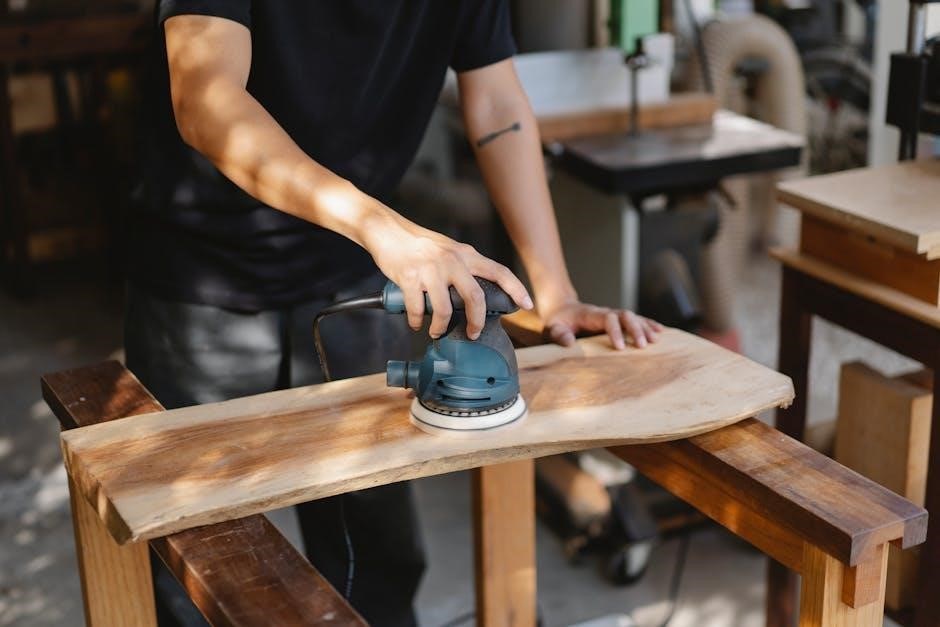
Advanced Techniques and Projects
Explore intricate designs and precision cutting with advanced techniques. Create complex patterns, custom fretwork, and decorative items. Expand your creativity with detailed woodworking and craft projects using the scroll saw.
10.1 Creating Complex Designs with Precision
Mastering intricate cuts and detailed patterns is achievable with the Old Craftsman Scroll Saw. The manual highlights techniques for precision cutting, enabling users to craft complex designs effortlessly. By understanding blade selection and variable speed control, you can tackle challenging projects with accuracy. Tips on maintaining blade tension and proper material feeding ensure smooth operation. This section encourages users to explore advanced woodworking and craft ideas, helping them achieve professional-level results with ease and creativity.
10.2 Using the Scroll Saw for Woodworking and Crafts
The Old Craftsman Scroll Saw is a versatile tool for woodworking and crafts, ideal for creating intricate patterns and designs. It excels in cutting various materials, including wood, plastic, and thin metal. Perfect for crafting decorative items, toys, and custom shapes, the saw allows for precise control. The manual provides guidance on optimizing settings for different projects, making it a valuable resource for both beginners and experienced craftsmen. With its variable speed and blade options, it empowers users to bring their creative visions to life with ease and precision.
10.3 Tips for Achieving Professional-Level Results
To achieve professional-level results with your Old Craftsman Scroll Saw, ensure proper setup and blade selection. Always secure the workpiece firmly to prevent movement during cutting. Use the variable speed control to match the material being cut, and maintain steady, consistent motion. Practice on scrap material to refine techniques. Follow the manual’s guidance for optimal blade tension and lubrication. Attention to detail and patience will elevate your craftsmanship, allowing you to create intricate and precise designs with ease.
The Old Craftsman Scroll Saw Manual provides a comprehensive guide to safe, effective, and creative use, ensuring users maximize their tool’s potential with confidence and precision.
11.1 The Importance of Following the Manual
Adhering to the Old Craftsman Scroll Saw Manual is crucial for ensuring safety, optimal performance, and longevity of the tool. It provides clear guidelines on operation, maintenance, and troubleshooting, helping users avoid potential hazards and achieve professional results. By following the manual, users can prevent accidents, reduce wear and tear, and make the most of their scroll saw’s capabilities. Proper adherence also ensures warranty compliance, safeguarding investments and promoting creative success in woodworking and crafting projects.
11.2 Maximizing the Potential of Your Scroll Saw
To maximize your scroll saw’s potential, understanding its features and capabilities is essential. The manual highlights variable speed control, ideal for various materials, and proper blade selection for precise cuts. Regular maintenance ensures optimal performance and longevity. By mastering these aspects, you can tackle intricate designs and achieve professional-level results. Exploring creative possibilities and following the manual’s guidance will help you unlock the full potential of your Old Craftsman Scroll Saw, making it an indispensable tool for woodworking and crafting projects.
11.3 Encouragement to Explore Creative Possibilities
Your Old Craftsman Scroll Saw is a gateway to endless creativity. With its precision and versatility, it empowers you to craft intricate designs, from delicate woodwork to artistic patterns. Experiment with various materials and techniques to unlock new possibilities. The manual’s guidance and troubleshooting tips ensure confidence in your projects. Embrace the joy of creating unique pieces, whether for personal satisfaction or as a gift. Let your imagination flourish, and transform raw materials into masterpieces with your trusty scroll saw by your side.



